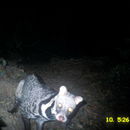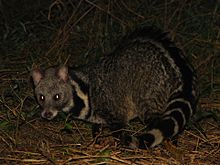en
names in breadcrumbs


Viverra zibetha are secretive and nocturnal. Therefore there is little comprehensive data on its natural history characteristics. Natural life span averages 15 years. Iin captivity they have lived over 20 years.
Perception Channels: tactile ; chemical
The Ahmedabad Zoo in India has a small population of Indian civets. They were formerly kept in order to collect their glandular secretions.
US Federal List: no special status
CITES: no special status
IUCN Red List of Threatened Species: near threatened
Viverra zibetha prey upon domestic animals, such as chickens, placing them in conflict with farmers.
Viverra zibetha secrete a substance called civet. It is used commercially to produce perfumes. They may also influence forest structure and re-growth by aiding in seed dispersal.
Civets are carnivorous. They prey on birds, frogs, snakes, small mammals, chickens, and hens. They also eat fruit, roots, eggs, and have been recorded eating fish and crabs.
Viverra zibetha, also known as the Indian civet, is found from Indochina to southern China. It is also found in Nepal, Bangladesh, the Malay Peninsula, Hainan, and Vietnam.
Biogeographic Regions: oriental (Native )
Viverra zibetha live in grasslands, scrub, and densely forested areas. They are commonly found near human habitats. They live in burrows that have been dug by other animals.
Terrestrial Biomes: savanna or grassland ; forest ; rainforest
Average lifespan
Status: captivity: 20.0 years.
Average lifespan
Status: captivity: 15.0 years.
Indian civets have large bodies that are gray or brown in color. Body length is about 34 inches with a tail length of 13 inches. They have black spots on the body as well as black and white stripes on the sides of the neck. In most cases there are two white stripes and three black stripes. The tail has a number of black rings around it. Limbs are black and the forefeet contain lobes of skin on the third and fourth digit that protect the retractile claws. Males are slightly larger than females.
Range mass: 5 to 11 kg.
Other Physical Features: endothermic ; homoiothermic; bilateral symmetry
Sexual Dimorphism: male larger
Females are polyestrous, breeding throughout the year. They have two litters per year and each litter can have up to four young. They are born in a hole in the ground or in very dense vegetation. Young can open their eyes in ten days and begin being weaned at one month of age. Weight at birth is less than 100g and doubles in 12 days. At the end of one month, the birth weight has increased four fold. The females raise the young on their own.
Key Reproductive Features: gonochoric/gonochoristic/dioecious (sexes separate); sexual
Average number of offspring: 3.
The large Indian civet (Viverra zibetha) is a viverrid native to South and Southeast Asia. It is listed as Least Concern on the IUCN Red List. The global population is considered decreasing mainly because of trapping-driven declines in heavily hunted and fragmented areas, notably in China, and the heavy trade as wild meat.[1]
The large Indian civet is grey or tawny and has a black spinal stripe running from behind the shoulders to the root of the tail. The front of the muzzle has a whitish patch emphasized by blackish behind on each side. The chin and fore throat are blackish. The sides and lower surface of the neck are banded with black stripes and white spaces in between. The tail has a variable number of complete black and white rings. Its claws are retractable. The soles of the feet are hairy.[2]
As indicated by its common name, this is a relatively large civet, almost certainly the largest of the Viverra species and exceeded in size among the Viverridae family only by African civets and binturongs. Its head-and-body length ranges from 50–95 cm (20–37 in) with a 38–59 cm (15–23 in) long tail. The hind foot measures 9–14.5 cm (3.5–5.7 in). Its weight ranges from 3.4–9.2 kg (7.5–20.3 lb). Some sources claim the species can weigh up to 11 kg (24 lb) (though possibly attained in captivity).[3][4][5]
The large Indian civet ranges from Nepal, northeast India, Bhutan, Bangladesh to Myanmar, Thailand, the Malay peninsula and Singapore to Cambodia, Laos, Vietnam and China.[1]
In Nepal, large Indian civet was recorded up to 2,250 m (7,380 ft) in the Himalayas, which constitutes the highest altitudinal record in this country.[6]
In China, the wild large Indian civet population declined drastically by 94–99% since the 1950s following deforestation, due to hunting for the fur trade, use of its musk glands as medicine and for the perfume industry.[3] By the 1990s, it was largely confined to the north of Guangdong Province in southern China, but has not been recorded in Hainan Island during surveys between 1998 and 2008.[7]

The large Indian civet is solitary and nocturnal. It spends most of the time on the ground. Its diet includes fish, birds, lizards, frogs, insects, scorpions and other arthropods, crabs, as well as poultry and rubbish. Little is known about its breeding behaviour. It is thought that it breeds throughout the year and has two litters per year, with two to four young per litter.[8]
Radio-tracked large Indian civets in Thailand had home ranges of 2.7 to 8.8 km2 (1.0 to 3.4 sq mi).[9]
Viverra zibetha is totally protected in Malaysia under the Wildlife Protection Act of 1972 and listed on Category II of the China Wildlife Protection Law. China listed it as ‘Endangered’ under criteria A2acd, and it is a class II protected State species (due to trapping for food and scent glands). It is protected in Thailand, Vietnam and Myanmar. It is found in several protected areas throughout its range. The population of India is listed on CITES Appendix III.[1]
In Hong Kong, it is a protected species under the Wild Animals Protection Ordinance Cap 170, though it has not been recorded in a natural state in Hong Kong since the 1970s, and is considered extirpated.[10]

Viverra zibetha was the scientific name for the large Indian civet introduced by Carl Linnaeus in 1758.[11] Several naturalists proposed species and subspecies in the 19th and 20th centuries, of which the following were recognised as valid subspecies by 2005:[12]
The validity of Viverra tainguensis described in 1997 by Sokolov, Rozhnov and Pham Chong from Tây Nguyên in Gia Lai Province in Vietnam has been seriously questioned, and it is now generally considered a synonym of V. zibetha.[1]
The large Indian civet (Viverra zibetha) is a viverrid native to South and Southeast Asia. It is listed as Least Concern on the IUCN Red List. The global population is considered decreasing mainly because of trapping-driven declines in heavily hunted and fragmented areas, notably in China, and the heavy trade as wild meat.